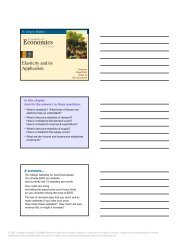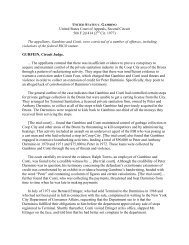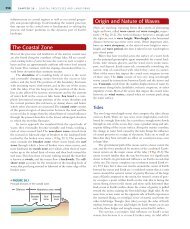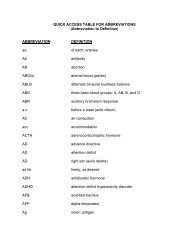Cite as: 191 Wis.2d 322, 528 NW2d 85
Cite as: 191 Wis.2d 322, 528 NW2d 85
Cite as: 191 Wis.2d 322, 528 NW2d 85
Create successful ePaper yourself
Turn your PDF publications into a flip-book with our unique Google optimized e-Paper software.
<strong>528</strong> N.W.2d <strong>85</strong> Page 1<br />
(<strong>Cite</strong> <strong>as</strong>: <strong>191</strong> <strong>Wis.2d</strong> <strong>322</strong>, <strong>528</strong> N.W.2d <strong>85</strong>)<br />
Court of Appeals of Wisconsin.<br />
STATE of Wisconsin, Plaintiff-Respondent,<br />
v.<br />
Anthony J. WAGNER, Defendant-Appellant.<br />
Petition for Review denied.<br />
Nos. 94-0978-CR, 94-0979-CR and 94-0980-CR.<br />
<strong>528</strong> N.W.2d <strong>85</strong>, <strong>191</strong> <strong>Wis.2d</strong> <strong>322</strong><br />
Submitted on Briefs Dec. 1, 1994.<br />
Opinion Rele<strong>as</strong>ed Jan. 31, 1995.<br />
Opinion Filed Jan. 31, 1995.<br />
Defendant w<strong>as</strong> convicted in the Circuit Court, Milwaukee County, Jeffrey A. Kremers, J., of two counts of<br />
attempted first-degree sexual <strong>as</strong>sault, one count of kidnapping while armed, and one count of attempted kidnapping<br />
while armed, and w<strong>as</strong> sentenced to prison term of 72 years. Defendant appealed. The Court of Appeals, Fine, J., held<br />
that: (1) forced movement of person from one room to another in same building satisfies “carries another from one<br />
place to another” element of kidnapping statute; (2) trial court acted within scope of its discretion in admitting other<br />
acts evidence consisting of witness’ testimony that defendant, without gun, had forced her into laundromat’s<br />
bathroom and sexually <strong>as</strong>saulted her, particularly <strong>as</strong> similarity of incidents w<strong>as</strong> probative of identity of who attacked<br />
instant victims; (3) there w<strong>as</strong> sufficient identification evidence, particularly both victims’ identifications of<br />
defendant in lineup before trial <strong>as</strong> their <strong>as</strong>sailant, to support convictions; and (4) trial court properly exercised its<br />
discretion in sentencing defendant to term of 72 years out of possible 94 years.<br />
Affirmed.<br />
**86 *326 On behalf of the defendant-appellant, the cause w<strong>as</strong> submitted on the briefs of Christopher Lowe of<br />
Lowe Law Offices, S.C., Milwaukee.<br />
On behalf of the plaintiff-respondent, the cause w<strong>as</strong> submitted on the briefs of James E. Doyle, Atty. Gen., and<br />
Sharon Ruhly, Asst. Atty. Gen.<br />
**87 Before WEDEMEYER, P.J., and SULLIVAN and FINE, JJ.<br />
FINE, Judge.<br />
Anthony Wagner appeals his conviction of two counts of attempted first- degree sexual <strong>as</strong>sault, see § 940.31(1)(a),<br />
Stats., one count of kidnapping while armed, see § § 940.31(1)(a) and 939.63(1), Stats., and one count of attempted<br />
kidnapping while armed, see § § 940.31(1)(a), 939.32 and 939.63(1), Stats. He raises four issues for our review: (1)<br />
whether what he calls the “slight movement” of his victims in the same building constitutes kidnapping under §<br />
940.31(1)(a); (2) whether the trial court erred in admitting “other acts” evidence under Rule 904.04(2), Stats.; (3)<br />
whether there w<strong>as</strong> sufficient evidence presented at trial to convict him; and (4) whether the trial court *327<br />
erroneously exercised its discretion in sentencing him to a prison term of seventy-two years. We affirm.<br />
I.<br />
Wagner accosted Candace I. on October 24, 1990, in a laundromat at 3910 North 76th Street in Milwaukee. He<br />
approached her from behind, put a gun to her right side, and tried to force her into the bathroom a few feet away.<br />
She struggled and escaped. On June 11, 1991, Wagner accosted Megan M. in a laundromat at 10440 West Silver<br />
Spring Drive in Milwaukee. As with Candace I. eight months earlier, he approached her from behind and put a gun<br />
to her right side. This time, however, he w<strong>as</strong> able to force his victim into the laundromat’s bathroom. While in the<br />
bathroom, Megan M. refused his demand that she remove her clothes. After a struggle, she escaped.<br />
II.
<strong>528</strong> N.W.2d <strong>85</strong> Page 2<br />
(<strong>Cite</strong> <strong>as</strong>: <strong>191</strong> <strong>Wis.2d</strong> <strong>322</strong>, <strong>528</strong> N.W.2d <strong>85</strong>)<br />
A. Asportation.<br />
Section 940.31(1)(a), Stats. (1991-1992), provides:<br />
(1) Whoever does any of the following is guilty of a Cl<strong>as</strong>s B felony:<br />
(a) By force or threat of imminent force carries another from one place to another without his consent and with<br />
intent to cause him to be secretly confined or imprisoned or to be carried out of this state or to be held to service<br />
against his will. [FN1]<br />
FN1. This provision w<strong>as</strong> amended into sex-neutral language by 1993 Wis. Act 486, § 586, effective June<br />
11, 1994.<br />
*328 Whether the forced movement of a person from one room to another in the same building satisfies the “carries<br />
another from one place to another” element of § 940.31(1)(a) is a question of first impression in Wisconsin. On our<br />
de novo review, see State v. Theriault, 187 <strong>Wis.2d</strong> 125, 131, 522 N.W.2d 254, 257 (Ct.App.1994) (application of<br />
statutes to undisputed facts is a legal issue that we review de novo ), we conclude that it does.<br />
Although under the common law, kidnapping “w<strong>as</strong> the forcible abduction of a person from one country to another,”<br />
the focus of modern-day kidnapping statutes is generally on the harm caused by the confinement. United States v.<br />
Garcia, <strong>85</strong>4 F.2d 340, 343 (9th Cir.1988), cert. denied, 490 U.S. 1094, 109 S.Ct. 2439, 104 L.Ed.2d 995. The<br />
confinement, however, “need not exist for any particular length of time.” Lange v. Young, 869 F.2d 1008, 1010 (7th<br />
Cir.1989) (applying Wisconsin law), cert. denied, 490 U.S. 1094, 109 S.Ct. 2440, 104 L.Ed.2d 996. By the same<br />
token, the critical <strong>as</strong>pect of the <strong>as</strong>portation element is “not the distance the victim is transported but the unlawful<br />
compulsion against the will to go somewhere.” State v. Williams, 111 Ariz. 222, 526 P.2d 1244, 1246 (1974) (forced<br />
movement from one room to another within house). See also Ellis v. State, 211 Ga.App. 605, 440 S.E.2d 235, 239<br />
(1994) (forced movement of victim “from her den to her bedroom w<strong>as</strong> sufficient evidence” to support defendant’s<br />
kidnapping conviction); Burton v. State, 426 A.2d 829, 833 (Del.1981) (kidnapping found where “defendant forced<br />
the victim to move from room to room”); Eckert v. Sheriff, Clark County, 92 Nev. 719, 557 P.2d 1150, 1151 (1976)<br />
(“it is enough, to support the kidnapping charges, that the victims were forcibly moved only a short distance within<br />
the house”). Here, Wagner forced Megan M. from an area of **88 *329 the laundromat that w<strong>as</strong> open to public view<br />
into the bathroom--an area that w<strong>as</strong> hidden from the public. There, according to the evidence that the jury could<br />
believe, he intended to sexually <strong>as</strong>sault her, thus satisfying the “[holding] to service against [her] will” element of<br />
the statute. See State v. Clement, 153 <strong>Wis.2d</strong> 287, 292-295, 450 N.W.2d 789, 790-792 (Ct.App.1989) (“sexual<br />
<strong>as</strong>sault is within the scope of ‘service against her will’ “). This analysis also applies to Wagner’s conviction for<br />
attempted kidnapping, where his efforts to force Candace I. into the bathroom were thwarted by her escape.<br />
Section 939.32(3), Stats., provides:<br />
An attempt to commit a crime requires that the actor have an intent to perform acts and attain a result which, if<br />
accomplished, would constitute such crime and that he does acts toward the commission of the crime which<br />
demonstrate unequivocally, under all the circumstances, that he formed that intent and would commit the crime<br />
except for the intervention of another person or some other extraneous factor.<br />
A victim’s successful resistance to a kidnapping is an “extraneous factor.” Clark v. State, 92 <strong>Wis.2d</strong> 617, 636-637,<br />
286 N.W.2d 344, 352 (1979) (attempted kidnapping found where defendant “w<strong>as</strong> prevented from carrying out the<br />
[kidnapping] by circumstances beyond his control, namely, the victim’s resistance”). In this c<strong>as</strong>e, the “extraneous<br />
factor” that prevented Wagner from kidnapping Candace I. on October 24, 1990, w<strong>as</strong> her escape.<br />
B. “Other acts” evidence.<br />
*330 Wagner argues that the trial court erred in admitting “other acts evidence” under Rule 904.04(2), Stats. Rule<br />
904.04(2) provides:<br />
Evidence of other crimes, wrongs, or acts is not admissible to prove the character of a person in order to show that<br />
the person acted in conformity therewith. This subsection does not exclude the evidence when offered for other<br />
purposes, such <strong>as</strong> proof of motive, opportunity, intent, preparation, plan, knowledge, identity, or absence of<br />
mistake or accident.
<strong>528</strong> N.W.2d <strong>85</strong> Page 3<br />
(<strong>Cite</strong> <strong>as</strong>: <strong>191</strong> <strong>Wis.2d</strong> <strong>322</strong>, <strong>528</strong> N.W.2d <strong>85</strong>)<br />
The decision to admit evidence under Rule 904.04(2) is within the trial court’s sound discretion, State v. Pharr, 115<br />
<strong>Wis.2d</strong> 334, 342, 340 N.W.2d 498, 501 (1983), and will not be upset on appeal if the decision h<strong>as</strong> a re<strong>as</strong>onable b<strong>as</strong>is<br />
in the evidence and w<strong>as</strong> made in accordance with accepted legal principles, State v. Jenkins, 168 <strong>Wis.2d</strong> 175, 186,<br />
483 N.W.2d 262, 265 (Ct.App.1992), cert. denied, 506 U.S. 1002, 113 S.Ct. 608, 121 L.Ed.2d 543. The proponent<br />
of the evidence h<strong>as</strong> the burden to show that it is relevant to an issue other than propensity. State v. Speer, 176<br />
<strong>Wis.2d</strong> 1101, 1114, 501 N.W.2d 429, 433 (1993). Once that burden h<strong>as</strong> been met, the evidence is admitted unless<br />
the opponent can show that the probative value of the other crimes evidence is “substantially outweighed by the<br />
danger of unfair prejudice,” Rule 904.03, Stats. See Speer, 176 <strong>Wis.2d</strong> at 1114, 501 N.W.2d at 433.<br />
The State called a witness who testified that Wagner attacked her in a laundromat in July of 1992. She testified that<br />
Wagner, who did not have a gun, forced her into the laundromat’s bathroom and sexually <strong>as</strong>saulted her. In denying<br />
Wagner’s motion in limine to exclude that testimony, the trial court ruled that the *331 evidence w<strong>as</strong> relevant not<br />
only to “identification, which is the issue in this c<strong>as</strong>e, but also <strong>as</strong> to a common plan or scheme and motive.” The trial<br />
court also noted that merely because the defendant w<strong>as</strong> “not contesting those, that doesn’t mean that the State<br />
doesn’t have to prove it.” [FN2] The trial court also determined that the “probative value” of the other crimes<br />
evidence “clearly outweigh[ed] the danger of unfair prejudice.” [FN3]<br />
FN2. The trial court correctly noted that the State may introduce evidence relevant to an issue that it must<br />
prove even though the defendant does not contest that issue. See Estelle v. McGuire, 502 U.S. 62, 69- 70,<br />
112 S.Ct. 475, 480-81, 116 L.Ed.2d 3<strong>85</strong> (1991).<br />
FN3. The trial court thus imposed upon the defendant a lower burden than provided for by Rule 904.03,<br />
Stats., which, <strong>as</strong> noted, requires exclusion of otherwise admissible evidence if the probative value of that<br />
evidence is “substantially outweighed by the danger of unfair prejudice.”<br />
**89 We agree that the similarity of the incidents is probative of the identity of who attacked the two victims in this<br />
c<strong>as</strong>e. See Whitty v. State, 34 <strong>Wis.2d</strong> 278, 292, 149 N.W.2d 557, 563 (1967) (evidence of other crimes is admissible<br />
when probative of, inter alia, identity), cert. denied, 390 U.S. 959, 88 S.Ct. 1056, 19 L.Ed.2d 1155. The trial court<br />
acted well within the scope of its discretion.<br />
C. Sufficiency of the evidence.<br />
Wagner argues that there w<strong>as</strong> insufficient evidence presented at trial to convict him. We disagree.<br />
[I]n reviewing the sufficiency of the evidence to support a conviction, an appellate court may not substitute its<br />
judgment for that of the trier of fact unless the evidence, viewed most favorably to the *332 state and the<br />
conviction, is so lacking in probative value and force that no trier of fact, acting re<strong>as</strong>onably, could have found<br />
guilt beyond a re<strong>as</strong>onable doubt. If any possibility exists that the trier of fact could have drawn the appropriate<br />
inferences from the evidence adduced at trial to find the requisite guilt, an appellate court may not overturn a<br />
verdict even if it believes that the trier of fact should not have found guilt b<strong>as</strong>ed on the evidence before it.<br />
State v. Poellinger, 153 <strong>Wis.2d</strong> 493, 507, 451 N.W.2d 752, 757-758 (1990) (citation omitted). Both victims in this<br />
c<strong>as</strong>e identified Wagner in a lineup before trial <strong>as</strong> their <strong>as</strong>sailant. Although Wagner argues that there were significant<br />
differences between his appearance and the victims’ descriptions of their attacker, it is the function of the trier of<br />
fact, however, and not of an appellate court, to resolve conflicts in the testimony, to weigh the evidence, and to draw<br />
re<strong>as</strong>onable inferences from b<strong>as</strong>ic facts to ultimate facts. Id., 153 <strong>Wis.2d</strong> at 506-507, 451 N.W.2d at 757.<br />
D. Sentence.<br />
Wagner argues that the trial court erroneously exercised its discretion in sentencing Wagner to a seventy-two year<br />
prison term. Sentencing is within the trial court’s discretion and will only be overturned if there is an erroneous<br />
exercise of discretion or if discretion is not exercised. Ocan<strong>as</strong> v. State, 70 <strong>Wis.2d</strong> 179, 183-184, 233 N.W.2d 457,<br />
460 (1975). The exercise of discretion contemplates a process or re<strong>as</strong>oning b<strong>as</strong>ed on facts that are of record or that<br />
are re<strong>as</strong>onably derived by inference from the record, and a conclusion b<strong>as</strong>ed on a logical rationale founded upon<br />
proper legal standards. Id., 70 <strong>Wis.2d</strong> at 1<strong>85</strong>, 233 N.W.2d at 461. *333 Thus, a court may impose a sentence within<br />
the limits set by statute, ibid., if it considers appropriate factors.<br />
The primary factors to be considered in imposing sentence are the gravity of the offense, the character of the
















